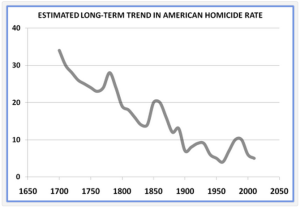[This post was co-authored with Stacy Rosenbaum of the University of Chicago and Lincoln Park Zoo.]
Huge swathes of central Africa’s rainforests remain unexplored by western science, but the forests of Virunga National Park have been the object of intense scientific scrutiny since George Schaller and Dian Fossey began their pioneering work there in the 1950s. Since 1967, the population of mountain gorillas in Virunga have been the subject of continuous scientific monitoring, numerous documentaries, and the Oscar-nominated biopic, Gorillas in the Mist.

Much of what we know about the ecology and social behavior of gorillas stems from the constant observation of the Virunga mountain gorillas. Many common primate behaviors were first discovered in this population, including male contest competition – when males fight for access to females over whom they maintain exclusive mating rights; sexually selected infanticide – when males kill other males’ infants in order to bring females into heat and redirect their maternal attention on future children; and scramble feeding competition – reliance on food sources that are not monopolizable, which minimizes the utility of female dominance hierarchies.
Gorillas display substantial sexual dimorphism. Specifically, the males are more than twice as large as the females and powerfully built. This underscores their evolutionary legacy of male contest competition and polygyny. Indeed, gorillas were long thought to exist almost exclusively in harems, small multi-female groups led by one powerful silverback. Eating mostly leafy greens and seasonal fruit, the herculean strength and sharp canine teeth of silverbacks are used only for fighting each other. Typically, young males leave their birth group upon reaching adulthood and go through a solitary period before attempting to take over a harem or start a group of their own. Most are not successful.

Beginning in the 1990s, something unexpected happened. Some younger males stopped leaving their groups and the basic harem social structure fundamentally shifted for about one-fourth of the park’s mountain gorilla population. Instead of groups with one, or occasionally two adult males, scientists began observing very large groups including several adult males and females living together in relative harmony. Some groups hosted up to nine adult males, and one group topped out at 66 total animals. Twenty years in, this trend shows no sign of reversing.
***
The recalibration of mountain gorilla social dynamics poses very pointed questions for the field of evolutionary psychology. With its earliest roots in the nineteenth century work of Edvard Westermarck on the incest taboo, this discipline attempts to understand human cognitive attributes through the lens of our evolutionary history.

Central to evolutionary psychological theory is the notion that behaviors are the product of natural selective forces that reward reproductive success. Though this claim may appear straightforward, many controversial corollaries have sprung from it. One that appears frequently in popular culture is the claim that some behavioral differences between men and women might be the result of innate, naturally selected differences in our constitution. Intangible phenomena like professional ambition, competitive tendencies, and desire for a rewarding family life, along with more concrete cognitive abilities such as spatial and quantitative reasoning, are sometimes invoked in the otherwise thoughtful conversations about why we don’t see more female astrophysicists on the Harvard faculty.
Much ink need not be shed regarding the potential damage to gender equality these conversations can do. However, some retort that if a given claim is supported by facts, it should not be silenced in deference to a social ideal. Steven Pinker, in particular, identifies strongly as a feminist and insists that doors of access must always be kept open. He would draw a line, however, if society pushes its social agenda so far that the potential achievement of some is sacrificed to develop the potential of others who may have less natural ability. Where that line might actually be found is difficult to say.

The problem, according to some, is that social engineering has costs. If men are, on average, naturally better than women at math, enforcing gender parity in top mathematics positions would mean elevating some of lesser natural ability over some with greater natural ability. The effect for society is a net loss in the fruits of our collective mathematics potential, quashed at the hands of social engineering.
Humans clearly harbor some average biological differences between the sexes. Male breasts rarely produce milk and women have no equivalent of the prostate gland. While there are some excellent female sprinters that could run circles around most men, the very fastest sprinters are all men and the average man is faster than the average woman.

Behavior, however, stems from the brain and its associated neurochemistry. The notion that brain anatomy is different between the sexes has been roundly discredited. On any one measure, for example the thickness of the corpus collosum, there may be average sex differences, but the ranges within the sexes are bigger than the average difference between them, and the ranges overlap substantially.
Crucially, any one individual will exhibit a combination of characteristically male and female measurements for different parts of the brain. The sum of this is that even an expert neuroanatomist has about a 50% chance of correctly predicting the sex of a brain based on anatomical measures. There is simply no such thing as a “male brain” and a “female brain,” at least not anatomically.

More to the point, research has yet to exclude environmental causes for the few observed sex differences in cognitive abilities. No child has ever been reared free of the pervasive influence of socially constructed gender norms. As Elizabeth Spelke and many others have shown, even the most feminist parents begin treating their male and female children differently on their first day of life. We are very far from knowing what males and females might naturally aspire to and be capable of, absent the influence of a social environment that shapes them to be, and to want to be, different.
Evolutionary psychology, seemingly the curmudgeon of progressive thinking, may actually provide the answer to the very dilemma it raises. In his passionate attack of “the blank slate” promoted by Stephen J. Gould and many other progressives, Pinker convincingly establishes the genetic basis of certain behaviors as drives, instincts, and tendencies that provide a wide, but not infinite, range of possible outcomes. Underneath this is a principle, as simple as it is elegant, that genes plus environment equals behavior.
While blank slate proponents ignore the role of genes in creating behavior, evolutionary psychologists may be underappreciating the role of environment. In their worry about men whose wings are clipped to make room for women, they forget the girls whose preferences are shaped by a world that tells them how cute they are, rather than how strong or how smart. In her new book, Beyond Biofatalism, Gillian Barker expresses the challenge saliently:
“Evolutionary psychologists focus on the Orwellian threat of overt unhappiness resulting from people’s inability to fulfill their preferences, or from forcible attempts to suppress those preferences, but in so doing, they overlook… the danger of a hidden or cryptic loss of happiness resulting from a limitation of people’s horizons that makes it impossible for them to form certain preferences in the first place.”
By obsessing over the costs and dangers of trying to over-correct gender differences in professional achievement, evolutionary psychologists may be showing insensitivity to the very forces responsible for the differences. After all, their own defining principle emphasizes the importance of context in any consideration of how drives are turned into behaviors.
***
The many scientists who study the Virunga mountain gorillas have yet to arrive at a convincing answer for why these animals suddenly overturned an apparently long-standing behavioral legacy. Regardless, their story is a fascinating example of social flexibility in a long-lived, big-brained primate. When Schaller and Fossey first observed them, it would have been virtually unimaginable to see six adult males co-existing, but this is now routine. While they are rarely close social partners, they work together to exclude outsiders and are remarkably tolerant of other males’ mating behavior.

The mountain gorilla silverbacks even ‘parent’ other males’ infants, and their collective protective abilities mean that infants in groups with more than one male are less likely to die of infanticide than infants born in a group where their father is the only male. Unsurprisingly, females apparently modify their social behavior in turn. Scientists have established that there are reproductive benefits for both sexes to living in multi-male groups.
We too have accomplished whole-scale behavioral transformations. Consider how different our behavior is compared to our prehistoric forebears, with whom we have no substantial genetic difference. In fact, Pinker is one of the biggest champions of this. His book, Better Angels of Our Nature: Why Violence Has Declined, chronicles the steady waning of violent deaths in human societies since the dawn of civilization. The social contract has allowed human beings to dramatically alter the way we interact with one another. Violence, even when warranted, is shunned in our youth and punished harshly in adults.
Pacification as a function of settled life is not limited to inter-personal violence; it extends to clan and state warfare. Just as laws and etiquette coerce individual behavior, treaties and sanctions nudge whole societies away from belligerence. Despite what sensationalist media headlines might have us believe, all forms of violent death have been on a steady decline for not hundreds, but thousands of years. We are living in the most peaceful time in the history of our species.

What is this if not social engineering? The leviathan restrains our natural instincts toward violence and instead, society redirects those instincts towards sports, professional ambition, and the like. Genes plus environment equals behavior.
The reason we don’t hear any concern about the smothering of our “true nature” as violent apes is obvious: we are all better off for having our behavior shaped in this way. There is nothing ‘unnatural’ about creating a social milieu that discourages violence any more than there is something unnatural about the way that Rwanda’s mountain gorillas are now living. Instincts are vague and only take shape as behaviors in the setting of a specific environment. What shape they take is highly contextual.
There are other examples as well. In developed countries, we have drifted away from communal living with extended relatives, instead preferring a more cozy domestic arrangement usually limited to immediate family. What was once a pervasive social structure now seems totally unmanageable, unnatural even, to those of us who grew up knowing nothing else.

Many evolutionary psychologists also distress over possible reductions in personal freedom that could result from pursuit of a social ideal. However, loss of freedom is not always bad. By prohibiting murder, we limit the success potential of a powerful person who might be otherwise inclined to murder rivals. But we still prohibit murder. By prohibiting theft, we limit the freedom of a worthy figure to seize resources from less powerful persons that he might be able to put to “better use.” But we still prohibit theft.
Matters of criminal justice are not the only areas in which we regularly apply social pressure to shape behavior. Public education, religion, role modeling, team-building exercises, even the Boy Scouts are forms of social engineering.
Once again, a lion of evolutionary psychology, David Buss, has said it best: “Human behavior is enormously flexible – a flexibility afforded by the large number of context-dependent evolved psychological adaptations that can be activated, combined, and sequenced to produce variable adaptive human behavior.”
The sheer rapidity with which women have entered the highest level of the work force, compared to just a generation ago, argues forcefully that professional ambition in women is hardly unnatural. It seems much more likely that keeping women away from professional life was unnatural in the first place. In this light, social efforts to facilitate gender equality and parity may not be coercive social engineering, but its opposite: the removal of coercion that has restrained women for far too long.

Questions of differing potential and preferences will likely persist for ages, but the observations of the mountain gorillas in Rwanda begs the question: If the gorilla can transform its entire social structure, flipping highly gendered behaviors totally around – and flourish in the process – can we not also? The answer is simple. Of course we can because we already have.
-NHL and Stacy Rosenbaum
[The authors do not speak on behalf of the Dian Fossey Gorilla Fund International, which has not endorsed the views represented here.]

“In this light, social efforts to facilitate gender equality and parity may not be coercive social engineering, but its opposite: the removal of coercion that has restrained women for far too long.”
I guess turning a caring loving mother into a back-stabbing psychopathic careerist is an advance in equality. But so is having everyone eat shit. I would rather live in a good world and you would rather live in an “equal” one.
I have no doubt that women can be as aggressive and selfish as men. I just don’t consider it a big achievement that we have managed to do this.
LikeLike
Your username correctly predicts the level of thoughtfulness in your comment.
LikeLiked by 1 person
“Consider how different our behavior is compared to our prehistoric forebears, with whom we have no substantial genetic difference”. I have a very simple question. Would you please explain how we know about the social structures and other behaviour patterns of our prehistoric forebears? After all, that supposed body of knowledge is the basis for the comparison you are making; so… how do we know about it?
LikeLike
I should clarify that by “prehistoric” I mean previous to the existence of any surviving artifacts (not just writing – e.g. buildings, works of art) that might give us concrete information about said behaviour patterns.
LikeLike
Your clarification makes your question a bit nonsensical. You’re asking me to provide evidence from a time period that you define as that from which we have no evidence.
Anyway, I used the word “prehistorical” to mean the period between the beginning of agricultural/settled life and the beginning of recorded history around 3.5k years ago. That’s around 8-10k years, much longer than we’ve had true civilization and we’ve lots of evidence telling us how those early settled societies lived. The point is that we’re not much different, genetically speaking, than those people were, yet we live very differently. If we go further back, it’s tougher to be sure that we aren’t genetically different so that’s why I compare only to the immediate prehistorical period. You seem to want to go much further, to the dawn of behavioral modernity or even to the early days of anatomically modern Homo sapiens. While it’s fascinating to wonder how they lived and you’re right that we have precious little evidence, it’s not relevant to the point I was making. I hope this helps.
LikeLike
This is quite interesting for sure. On the one hand, I come across research that suggests men tend to have greater variance in personality traits and many other areas such as IQ, height, weight and other factors than women, which would be an interesting biological explanation for why men tend to be more represented in areas such as academics or even criminal aggression. It wouldn’t so much be because men are inherently better than women at these things on average, but simply because men are more genetically variable than women in these areas, perhaps because women have an extra X chromosome to offset such genes. I’ve also seen it suggested that due to random X-inactivation in women’s cells such traits would average themselves out more than men due to men only have one X chromosome. Then there’s also all the research into sexual dimorphism in the human brain, of course, such as the fact that male brains seem to be 8 to 10% larger than female brains on average, as well as that female cerebral volume peaks earlier than male brains over the course of brain development.
However, fascinating research like the study that suggests male and female brains are a mosaic of different features, as well as the flexibility seen in gorilla behavior in this article definitely suggest a much more complicated picture. I’ve seen it claimed culture is a reflection and extension of our biology, but then such claims also seem to be made by people who staunchly defend behavior as deeply rooted in genetics, with little consideration for just how flexible human beings and other animals seem to be in regards to different environments. I have no doubt culture and behavior in general is indeed rooted genetics in many respects. If this weren’t the case, humans wouldn’t be what we are now. However, humans nor animals are not robots. We don’t just merely operate off of instinct. How much biology reinforces cultures nor how much we use culture to reinforce perceptions of our biology seems to be very clear. Those who staunchly defend biology as the source of all our behaviors may be just as culturally biased as those who claim the opposite. I certainly don’t have a satisfactory answer to any of this, seeing as I’m no expert in biology, nor psychology, but it’s certainly all very fascinating to me, though very confusing.
LikeLike